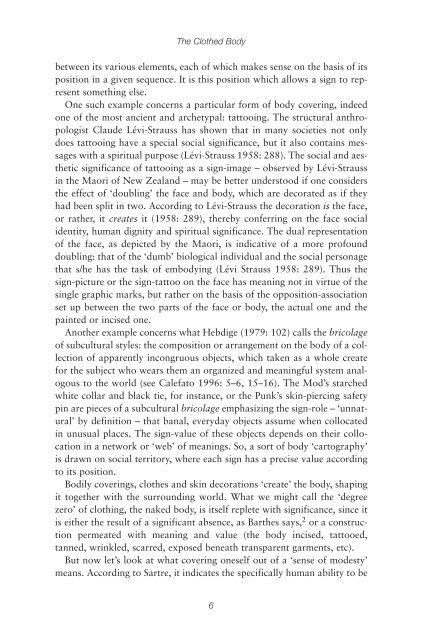You also want an ePaper? Increase the reach of your titles
YUMPU automatically turns print PDFs into web optimized ePapers that Google loves.
<strong>The</strong> <strong>Clothed</strong> <strong>Body</strong><br />
between its various elements, each of which makes sense on the basis of its<br />
position in a given sequence. It is this position which allows a sign to represent<br />
something else.<br />
One such example concerns a particular form of body covering, indeed<br />
one of the most ancient and archetypal: tattooing. <strong>The</strong> structural anthropologist<br />
Claude Lévi-Strauss has shown that in many societies not only<br />
does tattooing have a special social significance, but it also contains messages<br />
with a spiritual purpose (Lévi-Strauss 1958: 288). <strong>The</strong> social and aesthetic<br />
significance of tattooing as a sign-image – observed by Lévi-Strauss<br />
in the Maori of New Zealand – may be better understood if one considers<br />
the effect of ‘doubling’ the face and body, which are decorated as if they<br />
had been split in two. According to Lévi-Strauss the decoration is the face,<br />
or rather, it creates it (1958: 289), thereby conferring on the face social<br />
identity, human dignity and spiritual significance. <strong>The</strong> dual representation<br />
of the face, as depicted by the Maori, is indicative of a more profound<br />
doubling: that of the ‘dumb’ biological individual and the social personage<br />
that s/he has the task of embodying (Lévi Strauss 1958: 289). Thus the<br />
sign-picture or the sign-tattoo on the face has meaning not in virtue of the<br />
single graphic marks, but rather on the basis of the opposition-association<br />
set up between the two parts of the face or body, the actual one and the<br />
painted or incised one.<br />
Another example concerns what Hebdige (1979: 102) calls the bricolage<br />
of subcultural styles: the composition or arrangement on the body of a collection<br />
of apparently incongruous objects, which taken as a whole create<br />
for the subject who wears them an organized and meaningful system analogous<br />
to the world (see Calefato 1996: 5–6, 15–16). <strong>The</strong> Mod’s starched<br />
white collar and black tie, for instance, or the Punk’s skin-piercing safety<br />
pin are pieces of a subcultural bricolage emphasizing the sign-role – ‘unnatural’<br />
by definition – that banal, everyday objects assume when collocated<br />
in unusual places. <strong>The</strong> sign-value of these objects depends on their collocation<br />
in a network or ‘web’ of meanings. So, a sort of body ‘cartography’<br />
is drawn on social territory, where each sign has a precise value according<br />
to its position.<br />
Bodily coverings, clothes and skin decorations ‘create’ the body, shaping<br />
it together with the surrounding world. What we might call the ‘degree<br />
zero’ of clothing, the naked body, is itself replete with significance, since it<br />
is either the result of a significant absence, as Barthes says, 2 or a construction<br />
permeated with meaning and value (the body incised, tattooed,<br />
tanned, wrinkled, scarred, exposed beneath transparent garments, etc).<br />
But now let’s look at what covering oneself out of a ‘sense of modesty’<br />
means. According to Sartre, it indicates the specifically human ability to be<br />
6

















